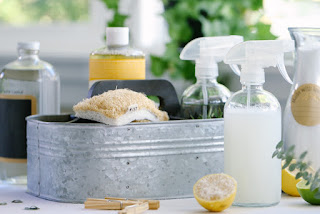Most modern cleaners contain dangerous chemicals that could cause health problems to sensitive individuals. Many of these cleaners also contribute to indoor and outdoor pollution. Luckily, there are various inexpensive alternatives to home cleaners that are less likely to damage one’s health and the environment. Here are some of them:
All-purpose cleaner: this solution is made by mixing ½ cup of white vinegar, ¼ cup of baking soda and ½ gallon of water. It can be used to clean, deodorize and disinfect surfaces. For dirtier surfaces, only white vinegar should be used, but a spot test should be performed first.
Tile cleaning: First, a paste of ½ water and ½ baking soda should be applied to the grout. After waiting a few minutes or up to 2 hours (for very dirty grout), the grout can be scrubbed with water.
Oven cleaning: Use a solution with 1 teaspoon of borax, 1 tablespoon of dishwashing liquid and 2 cups of hot water. Once the solution is applied, it should be wiped with a cloth after 20 minutes.
Window Washing: Use this solution of ½ teaspoon of liquid soap, ¼ cup of vinegar and 2 cups of water. The solution should be mixed into a spray bottle. Alternatively, rubbing alcohol can be used.
Furniture polishing: Use a mix of 2 tablespoons of lemon juice, 10 drops of pure lemon oil and 2-3 drops of olive oil. The solution should be used with a soft cloth to wipe off dust and give furniture a fresh look.
For various surfaces that are tough to clean, we recommend using a mix of 2 teaspoons of borax, 1 teaspoon of washing soda, 4 tablespoons of vinegar, ½ teaspoon of natural liquid soap and ¼ teaspoon of tea tree oil. The ingredients should be mixed with 2 cups of hot water into a spray bottle.
You can do your Dish Washing with a mix of equal parts borax and washing soda. If the water is hard, more washing soda can be utilized.
These are just some of the numerous green cleaning solutions that can be made at home using products available at regular stores. Many more can be made by experimenting. One last important thing to note: some substances should never be mixed, such as ammonia and bleach!
Using green products will help you have cleaner healthy indoor air!
All-purpose cleaner: this solution is made by mixing ½ cup of white vinegar, ¼ cup of baking soda and ½ gallon of water. It can be used to clean, deodorize and disinfect surfaces. For dirtier surfaces, only white vinegar should be used, but a spot test should be performed first.
Tile cleaning: First, a paste of ½ water and ½ baking soda should be applied to the grout. After waiting a few minutes or up to 2 hours (for very dirty grout), the grout can be scrubbed with water.
Oven cleaning: Use a solution with 1 teaspoon of borax, 1 tablespoon of dishwashing liquid and 2 cups of hot water. Once the solution is applied, it should be wiped with a cloth after 20 minutes.
Window Washing: Use this solution of ½ teaspoon of liquid soap, ¼ cup of vinegar and 2 cups of water. The solution should be mixed into a spray bottle. Alternatively, rubbing alcohol can be used.
Furniture polishing: Use a mix of 2 tablespoons of lemon juice, 10 drops of pure lemon oil and 2-3 drops of olive oil. The solution should be used with a soft cloth to wipe off dust and give furniture a fresh look.
For various surfaces that are tough to clean, we recommend using a mix of 2 teaspoons of borax, 1 teaspoon of washing soda, 4 tablespoons of vinegar, ½ teaspoon of natural liquid soap and ¼ teaspoon of tea tree oil. The ingredients should be mixed with 2 cups of hot water into a spray bottle.
You can do your Dish Washing with a mix of equal parts borax and washing soda. If the water is hard, more washing soda can be utilized.
These are just some of the numerous green cleaning solutions that can be made at home using products available at regular stores. Many more can be made by experimenting. One last important thing to note: some substances should never be mixed, such as ammonia and bleach!
Using green products will help you have cleaner healthy indoor air!


Comments
Post a Comment